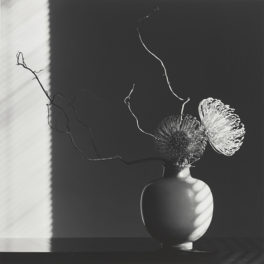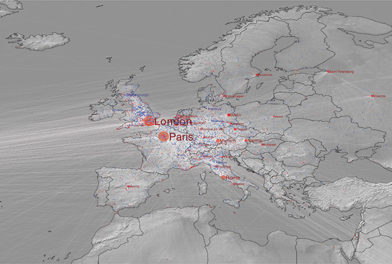
The first visitors to the newly opened Bauhaus Museum Weimar on April, 6, 2019. Third floor, Gropius collection. Photo: André Kühn, Klassik Stiftung Weimar
The Getty Research Institute exhibitions Bauhaus Beginnings (June 11–October 13, 2019) and Bauhaus: Building the New Artist (online from June 11) explore the founding years of the German Bauhaus, presenting rarely seen artworks, notes, and teaching materials from the Research Institute’s extensive Bauhaus archives. To complement the exhibitions, curators have invited research associate Anke Blümm from Weimar’s Bauhaus Museum to describe the school’s birthplace and legacy in the town of Weimar, Germany. —Ed.
The Bauhaus and its approaches have spread all over the world, but its origins lie in the lovely provincial town of Weimar, Germany. When we think of the Bauhaus’s beginnings—a key concept of the current Getty Research Institute exhibitions—it is illuminating to consider its original location in Weimar, in the German state of Thuringia.
For us at the Bauhaus Museum Weimar, this year’s centennial of the founding of the school (1919–2019) has offered the unique opportunity to present our collection in a new and larger museum building, which opened in April. The opening was the prelude to innumerable activities accompanying the Bauhaus centennial celebration throughout Germany. In this post I will introduce you to the Bauhaus’s original home in Weimar, the new museum building there, and how we present the Bauhaus’s legacy in its birthplace.
Weimar and Its Unique Bauhaus Collection
Weimar’s history dates to the Middle Ages, but it is most renowned for its rich cultural life in the eighteenth century, when poets Goethe and Schiller lived and worked here. In 1919, it was in a theater in Weimar that the national assembly gathered to found the first German democratic republic. In 2019, therefore, we celebrate the centennial not only of the Bauhaus, but of the Weimar Republic.
The Bauhaus dates back even earlier than 1919, however. Even before the First World War, cosmopolitan architect Henry van de Velde had begun to reform art education in Weimar, designing a new school building that became the home of the Bauhaus when Walter Gropius took over leadership of the school.
When he became director of the Bauhaus in 1919, Gropius announced three ideas:
- craft as the origin of art,
- architecture as the most important form of art, comprising all other arts and crafts, and
- the close and mutual connection between art and life.
Gropius invited some of the premier avant-garde artists of his day, including Paul Klee and Wassily Kandinsky, to be teachers at his new institution. The Bauhaus, however, was not beloved by the citizens of Weimar or the state of Thuringia. In 1924 the state cut its funding, forcing Gropius to move the school. He relocated it to Dessau, where he built the iconic Bauhaus building in 1926.
In this move, Gropius left a treasure behind: a collection of 168 prototypical objects he had collected to exemplify the school’s Weimar period. This collection of furniture, ceramics, textiles, and metal objects formed the basis of the Weimar Bauhaus collection. Today, the Bauhaus collection of the Klassik Stiftung Weimar comprises around 13,000 objects.
The Old and New Bauhaus Museum in Weimar
Despite the Bauhaus’s origins in Weimar, it took decades for the school to have its own museum here. Weimar is located in eastern Germany, in the former socialist German Democratic Republic (GDR), which initially considered the Bauhaus decadent and bourgeois. Only in the 1960 and 1970s did the reception of the Bauhaus begin to change in East Germany, when the Bauhaus building in Dessau (also in the GDR) was renovated.
In the 1990s, after German reunification, Weimar finally got its own Bauhaus museum in an old carriage house opposite the theater and the monument to Goethe and Schiller. The museum building was centrally located, but the space was far too small. In 2009 plans were made to build a new Bauhaus museum, but debate over the best site delayed the project for several years.

Aerial view of the Bauhaus Museum under construction (foreground left). The Nazi Gauforum is visible in the background. Photo: Klassik Stiftung Weimar
The selected location—near a former national-socialist compound and next to a parkway dating from the Weimar Republic—is highly symbolic. Weimar played a key role in the national-socialist movement, and after Hitler’s rise to power in 1933 the Nazis found Weimar a suitable site for one of Europe’s largest concentration camps, Buchenwald. The camp is only 10 kilometers away from Weimar city, while Weimar itself hosts one of the only completed Nazi city plans and parade grounds —the so-called Gauforum—which still shapes the area between the Weimar train station and the old city center. This proximity of the Gauforum to the Bauhaus Museum illustrates the ambivalence of concepts like “modernity” and “technological progress.”
Presenting the Bauhaus in Its Historical Context
For us at the Bauhaus Museum Weimar, it is important to show the Bauhaus in its complex historical and cultural context. The exhibition is therefore not chronological; instead, we tell the story of the Bauhaus in seven thematic sections.
We start with the new man, a concept born of the sweeping sociopolitical changes after the First World War. This section explores the cult of the body, sport, art, cinema, and the new role of women, and shows how the Bauhaus contributed iconic images of women’s new roles, such as women dancing and wearing new styles of clothes.

Bauhaus cradle, 1922, designed by Peter Keler. Photo: Klassik Stiftung Weimar. © Jan Keler
Next is experiment, which summarizes the early years at the Bauhaus. Teachers with different approaches to color, form, and material met open-minded and adventurous students, and together they created new objects, forms, and graphics—going far beyond what later became known as “the Bauhaus style.” Following two sections dedicated to the Bauhaus stage and the new living of the 1920s, the third floor greets visitors with the famous Gropius collection of 168 objects. We also introduce the two later directors of the Bauhaus, Hannes Meyer and Mies van der Rohe, to foreshadow the further history of the Bauhaus and the school’s simultaneous success and failure in Weimar.
The Haus Am Horn
In Weimar we are also lucky to have the first example of Bauhaus architecture, the House Am Horn, which has belonged to the Bauhaus World Heritage sites in Weimar since 1996. It was erected in 1923 on the occasion of the first, now legendary Bauhaus exhibition just outside of the large central park in Weimar. It was meant to be a model house for a single family with parents and one or two children, with a self-supporting garden.

Haus am Horn, designed by Georg Muche in 1923. Aerial view with vegetable garden. Courtesy of Klassik-Stiftung Weimar. Photo: Thomas Mueller 2019
At the center of the house is a twenty-square-foot clerestory-lit living room, with specialized rooms surrounding it on all four sides. Each room was fitted with specially designed furnishings and hardware created in the Bauhaus workshops. It was a true total work of art, in line with the collective idea of the Bauhaus. The house reopened on May 18, 2019, with a new permanent exhibition. Historic photos, outlines of lost furniture, and a media guide help visitors immerse themselves in the history of this unique building.
Bauhaus100 and Its Activities
Not only Weimar is celebrating the Bauhaus centennial this year. The Stiftung Bauhaus Dessau will open the doors of its new museum building on September 8, 2019, and the Bauhaus Archive in Berlin, which houses the largest Bauhaus collection in the world, will welcome visitors to a citywide Bauhaus festival in the first week of September.
Many smaller exhibitions and events are also taking place across Germany throughout the year, dedicated to specific Bauhaus teachers and students (in German, so-called Bauhäusler) and their work; to subsequent Bauhaus-inspired institutions; and to experimental Bauhaus approaches in art today. Showcasing all these activities is our collaborative website bauhaus100.com.
If you are in the United States, don’t miss the exhibitions Bauhaus Beginnings at the Getty, The Bauhaus and Harvard in Cambridge, and The Bauhaus at 100: Modern Legacies at LACMA—but I hope you also take a moment to recall where the Bauhaus was born.




Comments on this post are now closed.